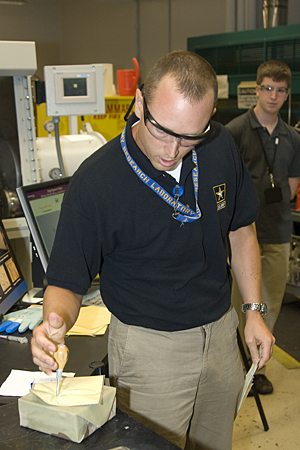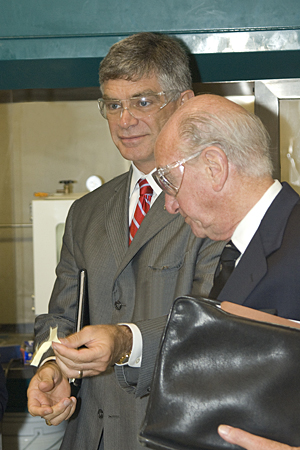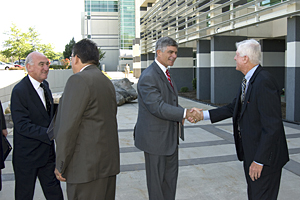


ADVERTISEMENT
- Rozovsky wins prestigious NSF Early Career Award
- UD students meet alumni, experience 'closing bell' at NYSE
- Newark Police seek assistance in identifying suspects in robbery
- Rivlin says bipartisan budget action, stronger budget rules key to reversing debt
- Stink bugs shouldn't pose problem until late summer
- Gao to honor Placido Domingo in Washington performance
- Adopt-A-Highway project keeps Lewes road clean
- WVUD's Radiothon fundraiser runs April 1-10
- W.D. Snodgrass Symposium to honor Pulitzer winner
- New guide helps cancer patients manage symptoms
- UD in the News, March 25, 2011
- For the Record, March 25, 2011
- Public opinion expert discusses world views of U.S. in Global Agenda series
- Congressional delegation, dean laud Center for Community Research and Service program
- Center for Political Communication sets symposium on politics, entertainment
- Students work to raise funds, awareness of domestic violence
- Equestrian team wins regional championship in Western riding
- Markell, Harker stress importance of agriculture to Delaware's economy
- Carol A. Ammon MBA Case Competition winners announced
- Prof presents blood-clotting studies at Gordon Research Conference
- Sexual Assault Awareness Month events, programs announced
- Stay connected with Sea Grant, CEOE e-newsletter
- A message to UD regarding the tragedy in Japan
- More News >>
- March 31-May 14: REP stages Neil Simon's 'The Good Doctor'
- April 2: Newark plans annual 'wine and dine'
- April 5: Expert perspective on U.S. health care
- April 5: Comedian Ace Guillen to visit Scrounge
- April 6, May 4: School of Nursing sponsors research lecture series
- April 6-May 4: Confucius Institute presents Chinese Film Series on Wednesdays
- April 6: IPCC's Pachauri to discuss sustainable development in DENIN Dialogue Series
- April 7: 'WVUDstock' radiothon concert announced
- April 8: English Language Institute presents 'Arts in Translation'
- April 9: Green and Healthy Living Expo planned at The Bob
- April 9: Center for Political Communication to host Onion editor
- April 10: Alumni Easter Egg-stravaganza planned
- April 11: CDS session to focus on visual assistive technologies
- April 12: T.J. Stiles to speak at UDLA annual dinner
- April 15, 16: Annual UD push lawnmower tune-up scheduled
- April 15, 16: Master Players series presents iMusic 4, China Magpie
- April 15, 16: Delaware Symphony, UD chorus to perform Mahler work
- April 18: Former NFL Coach Bill Cowher featured in UD Speaks
- April 21-24: Sesame Street Live brings Elmo and friends to The Bob
- April 30: Save the date for Ag Day 2011 at UD
- April 30: Symposium to consider 'Frontiers at the Chemistry-Biology Interface'
- April 30-May 1: Relay for Life set at Delaware Field House
- May 4: Delaware Membrane Protein Symposium announced
- May 5: Northwestern University's Leon Keer to deliver Kerr lecture
- May 7: Women's volleyball team to host second annual Spring Fling
- Through May 3: SPPA announces speakers for 10th annual lecture series
- Through May 4: Global Agenda sees U.S. through others' eyes; World Bank president to speak
- Through May 4: 'Research on Race, Ethnicity, Culture' topic of series
- Through May 9: Black American Studies announces lecture series
- Through May 11: 'Challenges in Jewish Culture' lecture series announced
- Through May 11: Area Studies research featured in speaker series
- Through June 5: 'Andy Warhol: Behind the Camera' on view in Old College Gallery
- Through July 15: 'Bodyscapes' on view at Mechanical Hall Gallery
- More What's Happening >>
- UD calendar >>
- Middle States evaluation team on campus April 5
- Phipps named HR Liaison of the Quarter
- Senior wins iPad for participating in assessment study
- April 19: Procurement Services schedules information sessions
- UD Bookstore announces spring break hours
- HealthyU Wellness Program encourages employees to 'Step into Spring'
- April 8-29: Faculty roundtable series considers student engagement
- GRE is changing; learn more at April 15 info session
- April 30: UD Evening with Blue Rocks set for employees
- Morris Library to be open 24/7 during final exams
- More Campus FYI >>
2:57 p.m., Aug. 23, 2010----After entering into a formal partnership with the U.S. Army Research, Development and Engineering Command (RDECOM) in January, leadership from the University of Delaware assembled on July 26 to tour Army Research Laboratory (ARL) facilities at Aberdeen Proving Ground.
UD President Patrick Harker, Senior Vice Provost Mark Barteau and David Weir, director of the Office of Economic Innovation and Partnerships, joined RDECOM representatives and ARL Director John Miller, met to discuss ideas on workforce development and how to further expand the Cooperative Research and Development Agreement.
According to Val Emery, outreach program manager, many ARL directorates at APG work very closely with the University, including the Weapons and Materials Research Directorate, the Survivability/Lethality Analysis Directorate and the Computational and Information Sciences Directorate. Recently the Vehicle Technology Directorate has also entered into a dialogue with the University.
As an element of RDECOM's mission to recruit, develop and retain a diverse and world class workforce, the Army hired a total of 23 University of Delaware students last year, either as full-time employees or through the Student Career Experience Program.
“During the BRAC (Base Realignment and Closure) of 1995, we made a conscious effort to bridge the gap and incorporate University of Delaware students,” said Miller. “Our relationship with UD goes back to that time frame.”
During the lab tour, Delaware alumni demonstrated fiber interfaces and resin development, technology used for lightweight and flexible armor. Eric Wetzel, of the Composite and Hybrid Materials Branch, and also a University of Delaware alumnus, spoke about the teamwork he has had with the university in the past and the quality students, personnel and skilled people that consistently work with ARL.
“In 2000, I worked with the University of Delaware as I continued research on shear thickening fluids,” Wetzel said. “From basic research, public relations and the licensing end, UD was there to assist.”
As APG continues to transform through BRAC actions, the University is looking for opportunities to work with the installation and improve the overall experience for the students.
"The partnership between the University of Delaware and Aberdeen Proving Ground is an exciting one,” Harker noted. “We're honored to offer support to the U.S. warfighter, and we're eager to capitalize on the opportunities we see for significant growth in collaborative education and research."
Harker also remains impressed with ARL's facilities. "The campus at Aberdeen is transforming into a remarkable site,” he said. “With these state-of-the-art research facilities and our combined expertise and assets, I know our collaboration will lead to big discoveries and groundbreaking technologies."
To complete the tour, Harker visited the Army's Material Center of Excellence in Composites, as well as the future site for Command, Control, Communications, Computers, Intelligence, Surveillance, and Reconnaissance (C4ISR) technologies.
Photos by Doug LaFon


